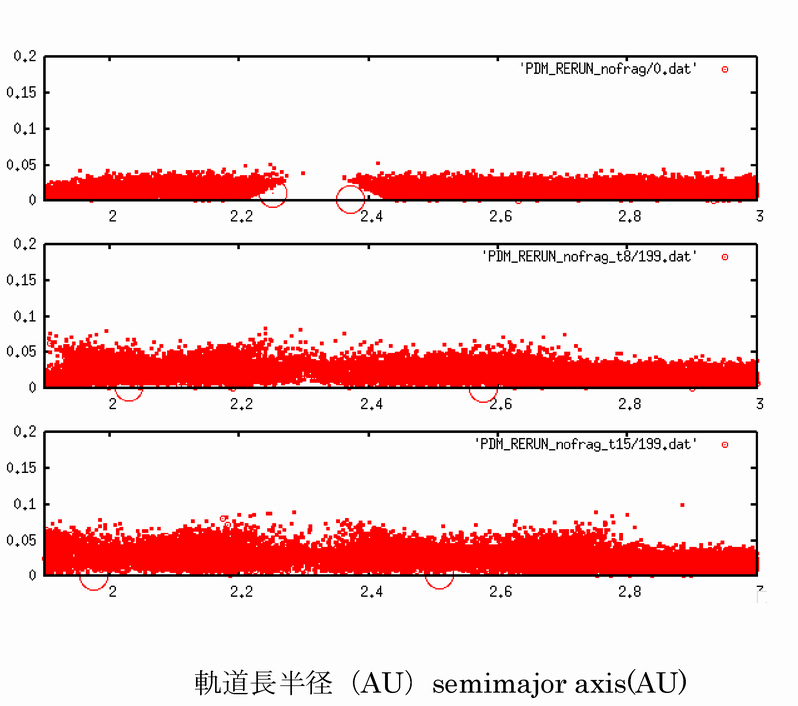Large Scale N-body simulation of Planet Formation : Outward Migration of a Protoplanet within a Gas Disk
JAXA Supercomputer System Annual Report April 2016-March 2017
Report Number: R16E0053
- Responsible Representative: Junko Kominami(Tokyo Institute of Technology)
- Contact Information: Masaki Fujimoto(fujimoto.masaki@jaxa.jp)
- Members: Junko Kominami
- Subject Category: Space(Space science)
Abstract
Planets are thought to be formed from dust in protoplanetary disks. However, so far, we have not succeeded to reproduce even our Solar system. I am carrying out N-body simulation in order to clarify how the planetary system was formed.
Goal
Protoplanet forms in a gas disk. We include the gas drag and type-I migration due to the gas disk and carried out more realistic simulation than before, testing whether the protoplanet can survive in the protoplanetary disk under the effect of type-I migration.
Objective
By including enough number of planetsimals in the simulation, I would like to see if the protoplanet moves outward overcoming the inward type-I migration.
References and Links
N/A
Use of the Supercomputer
We developed a code called Kninja which is a parallelized N-body code for planet formation using supercomputer K. In Kominami et al. (2016), we showed that a protoplanet moves outward in the disk and stops after a while when enough number of planetsimals were included. I changed the force calculation part so that the code can be used for SORA-MA.
Necessity of the Supercomputer
So far, number of particles we could calculate for N-body simulation was about 30 thousand even if special purpose accelerater called GRAPE was used. However, in order to express the inward and outward movement of the bodies, wider disk and larger number of particles (about 100 thousand particles) become necessary. We need to parallelize the code and use super computer.
Achievements of the Year
As for the initial condition, we used that of the second stage simulation in Kominami et al. (2016). We followed Kominami et al. (2005) for including the effect of gas drag and type-I migration. As for the result, first, the outer protoplanet moved outward since there is a gap in the disk and the gap works as a 'kick' for the planetesimal driven migration. However, the planetesimals residing right behind (outer side of the protoplanet) grows becuase of the accretion. One of the main criteria for the planetesimal driven migration to take place is the mass ratio of the protoplanet to the planetesimal has to be more than about 100. The assumption of perfect accretion let the planetesimals grow to the size that the criteria breaks down. Hence, outward migration stops and the inward migration started.

Fig.1:Snapshots of random velocity vs the semimajor axis. Top panel is the initial state, middle panel is t=240000 years and the bottom panel is 480000 years. The outer protoplanet once migrates outward, however, changes the direction afterwards due to type-I migration.
Publications
Presentations
1) Japan-Germany Planet Disk Workshop
6) JpGU
Computational Information
- Parallelization Methods: Hybrid Parallelization
- Process Parallelization Methods: MPI
- Thread Parallelization Methods: OpenMP
- Number of Processes: 168
- Number of Threads per Process: 32
- Number of Nodes Used: 168
- Elapsed Time per Case (Hours): 60
- Number of Cases: 3
Resources Used
Total Amount of Virtual Cost(Yen): 3,280,059
Breakdown List by Resources
| System Name | Amount of Core Time(core x hours) | Virtual Cost(Yen) |
|---|---|---|
| SORA-MA | 2,005,031.33 | 3,272,692 |
| SORA-PP | 0.75 | 6 |
| SORA-LM | 0.00 | 0 |
| SORA-TPP | 0.00 | 0 |
| File System Name | Storage assigned(GiB) | Virtual Cost(Yen) |
|---|---|---|
| /home | 4.77 | 34 |
| /data | 47.68 | 341 |
| /ltmp | 976.56 | 6,985 |
| Archiving System Name | Storage used(TiB) | Virtual Cost(Yen) |
|---|---|---|
| J-SPACE | 0.00 | 0 |
Note: Virtual Cost=amount of cost, using the unit price list of JAXA Facility Utilization program(2016)
JAXA Supercomputer System Annual Report April 2016-March 2017


